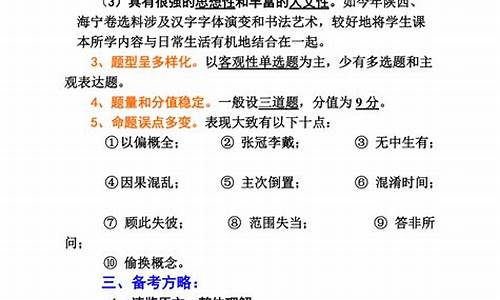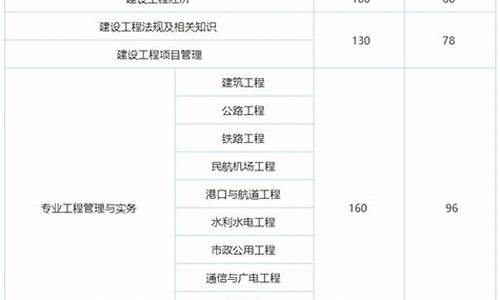您现在的位置是: 首页 > 热门专业 热门专业
2024高考英语状语从句_状语从句高考题和答案
tamoadmin 2024-06-05 人已围观
简介1.高考英语重点单词用法总结2.高考英语知识点考点总结归纳英语从句主要有三大分类:1. 名词性从句(包括主语从句,宾语从句,表语从句,同位语从句)2. 形容词性从句(定语从句)3. 副词性从句。始终搞不懂英语语法?点击蓝字链接领取免费试课:点击即可免费领取,外教一对一课程,课均不到20元,每天都能跟着专业外教学习专业的语法知识!学英语推荐来阿卡索外教网,专业外教一对一授课,性价比也是非常高的,半年
1.高考英语重点单词用法总结
2.高考英语知识点考点总结归纳

英语从句主要有三大分类:1. 名词性从句(包括主语从句,宾语从句,表语从句,同位语从句)2. 形容词性从句(定语从句)3. 副词性从句。
始终搞不懂英语语法?点击蓝字链接领取免费试课:点击即可免费领取,外教一对一课程,课均不到20元,每天都能跟着专业外教学习专业的语法知识!
学英语推荐来阿卡索外教网,专业外教一对一授课,性价比也是非常高的,半年4099元有180节外教课,课均不到20元,每天都能跟外教学习,各位可以点击上述蓝字去试一下,除了能提升英语技能外,还能有效锻炼口语水平。
不知道如何选择英语机构,可以百度咨询“阿卡索vivi老师”;
如果想下载免费英语资源,可以百度搜索“阿卡索官网论坛”。
高考英语重点单词用法总结
#高考# 导语英语是高考备考的重点,也是难点,很多词,英语易错词汇短语同学们分不太清楚,为帮助同学们解决这一重点难点, 考 网整理了《高考英语易错词汇短语辨析》,供参考。whatever,whoever,whichever引导名词性从句
一、基本用法概说
英语中的-ever 词主要包括 whatever, whoever, whichever, whenever, wherever, however 等,其中可引导名词性从句的主要有whatever, whoever,whichever.这里所说的名词性从句主要指主语从句和宾语从句,它们通常不用于引导同位语从句,同时也很少用于引导表语从句。如:
Whatever he said was right. 无论他说什么都是对的。(引导主语从句)
I don‘t believe whatever he said. 无论他说什么我都不信。(引导宾语从句)
在某些特定的语境中,也可用于引导表语从句。如:
What he wants to get is whatever you have. 他想得到的是你所拥有的一切。
二、whatever引导的名词性从句
whatever的意思是“所……的一切事或东西”,可视为what的强调说法,其含义大致相当于anything that,whatever在从句中可用作主语、宾语、定语。如:
Do whatever she tells you and you‘ll have peace. 她叫你干什么你就干什么,那你就太平了。
I don‘t believe in letting children do whatever they like. 我不赞成让孩子为所欲为。
Goats eat whatever food they can find. 山羊找到什么食物就吃什么食物。
三、whoever引导的名词性从句
whoever的意思“任何……的人”,在意义上大致相当于 anybody who.whoever在从句中可用作主语或宾语。如:
I‘ll take whoever wants to go. 谁想去我就带谁去。
Whoever says that is a liar. 说那话的人是个骗子。
She can marry whoever she chooses. 她愿意嫁谁就嫁谁。
I‘ll give the ticket to whoever wants it. 谁想要这票,我就把它给谁。
Tell whoever you like — it makes no difference to me. 你爱告诉谁就告诉谁吧,对我是无所谓的。
注:whoever既用作主语也可用作宾语(作宾语时不宜用whomever,因为在现代英语中whomever已几乎不用)。另外,注意以下受汉语意思影响而弄错的句子:谁赢了都可以获奖。
误:Who wins can get a prize.误:Anyone wins can get a prize.正:Whoever wins can get a prize.正:Anyone who wins can get a prize.
四、whichever引导的名词性从句
whichever的意思“……的那个人或事物”,在意义上大致相当于 the person or the thing that.whichever在从句中可用作主语、宾语或定语。如:You can pick whichever one you like. 你喜欢哪个就挑哪个。
Whichever of you comes first will receive a prize. 你们谁第一谁就能得奖。
We‘ll eat at whichever restaurant has a free table. 哪个饭馆有空桌我们就在哪儿吃吧。
Whichever of us gets home first starts cooking. 我们当中无论哪个先到家,哪个就先开始做饭。
五、引导状语从句的用法
whatever, whoever, whichever除用于引导的名词性从句外,还可用于引导状语从句,分别相当于 no matter what, no matter who, no matter which.如:I‘ll stand by you whatever [=no matter what] happens. 无论如何我都支持你。
Whoever [=No matter who] wants to speak to me on the phone, tell them I‘m busy. 不管谁要我接电话,就说我现在正忙。
Whichever [=No matter which] you buy, there is a six-month guarantee. 不管买哪个都有六个月的保修期。
高考英语知识点考点总结归纳
高考的单词量是3000个,繁多且难以记忆。把重点的单词 总结 归纳起来,是不是容易多了?下面由我给你带来关于高考英语重点单词用法总结,希望对你有帮助!
高考英语重点单词用法总结1
1.able 用法:be able to do
Note: 反义词 unable表示不能,而disabled表示残疾的。
be able to do可以表示经过艰难困苦才能做到的事。
2.abroad 用法:表示到(在)国外,是一个副词,前面不加介词。
Note: 可以说from abroad, 表示从国外回来。
3.admit 用法:表示承认的时候后面要加上动名词形式。
Note: 表示允许进入的时候与介词to搭配。
4.advise 用法:advise sb. to do; advise doing
Note: 后面的宾语从句要用虚拟语气。即:advise that sb. (should) do的形式。
5.afford 用法:通常与动词不定式搭配使用。
Note: 前面需要有be able to或can等词。
6.after 用法:表示在时间、空间之后;be after表示追寻。
Note: 用在将来时的时候后面接一时间点,而in接一个时间段,如:after 3 o?clock; in 3 days.
7.agree 用法:与介词on, to, with及动词不定式搭配。
Note: agree on表示达成一致;agree to表示批准;agree with表示同意某人说的话。
8.alive 用法:表语性形容词,在句中只能作表语,不能作定语。
Note: 可以作状语使用,表示活活地,如:bury sb. alive.
9.allow 用法:allow doing; allow sb. to do
Note: 可以表示允许进入,如:Please allow me in.
10.among 用法:用在三者或三者以上的群体中。
Note: 还可以表示其中之一,如:He is among the best.
11.and 用法:用于连接两个词、 短语 、 句子 或其他相同结构。
Note: 与祈使句搭配时往往可以表示条件。如:Work hard, and you?ll succeed sooner or later.
12.another 用法:表示又一个,泛指,相当于one more的含义。
Note: 不能直接加复数名词,需要与一个数词搭配,如:another 2 weeks.
13.answer 用法:及物动词,但在作名词时要与介词to搭配。
Note: 可以表示接电话、应门等。如:answer the phone/door.
14.anxious 用法:be anxious for/about/to do
Note: be anxious about表示担心;be anxious for表示盼望得到。
15.appear 用法:不及物动词,没有宾语,没有被动语态。
Note: 还可以作为系动词,与seem同义,表示看起来?。
16.arrive 用法:arrive at表示到一个小地方;arrive in表示到一个大地方。
Note: 引申含义表示得出,如:arrive at a decision/conclusion.
17.ask 用法:ask to do; ask sb. to do; ask for
Note: 后面的宾语从句要用虚拟语气。即:ask that sb. (should) do的形式。
18.asleep 用法:表语性形容词,在句中只能作表语,不能作定语。
Note: 通常与动词be及fall搭配;sound asleep表示熟睡。
19.attend 用法:表示参加,后面经常加上meeting, lecture, conference, class, school, wedding, funeral等词;也可以表示照顾,照料。
Note: attend to可以表示处理、照料等。
20.attention 用法:pay attention to; draw/catch sb?s attention
Note: 写通知时的常用语:May I have your attention, please?
21.beat 用法:表示打败某人,或连续不断地击打某物。
Note: heartbeat表示心跳。
22.because 用法:后面接原因状语从句,because of后面接名词。
Note: because表示直接原因,因此只有用它才可以回答why的特殊疑问句及用在强调句中。
23.become 用法:系动词,表示变得?。可以由好变坏或由坏变好。
Note: become of sb.表示某人发生了什么事情。
24.before 用法:before long, long before, the day before yesterday, the week / year before last 上上周/前年
Note: It be + 段时间 before?在该句型中,主句时态只有将来时态和一般过去时态。
25.begin 用法:begin to do; begin doing
Note: 当begin本身是进行时的时候,只能用begin to do的形式。如:It was beginning to rain.
高考英语重点单词用法总结2
26.believe 用法:believe sb.表示相信某人说的话;believe in sb.表示信任;6123结构。
Note: 回答问句时通常用I believe so/not的形式。
27.besides 用法:表示除?之外还有,包含在一个整体之中。
Note: 还可以用作副词,表示此外,要用逗号隔开。
28.beyond 用法:表示越过、在另一边,如:beyond the wood/bridge.
Note: 可以用于引申含义,表示超出?,如:beyond control/power/description.
29.bit 用法:与a little一样可以修饰不可数名词,形容词或副词。
Note: 修饰名词时要用a bit of;not a bit表示一点也不。
30.blame 用法:take/bear the blame; blame sth. on. sb.
Note: 表示应受到责怪时不用被动语态,如:He is to blame.
31.blow 用法:blow down/away
Note: 表示风刮得很大时要用blow hard.
32.boil 用法:boiling表示沸腾的;boiled表示煮过的。
Note: boiling point可以表示沸点。
33.borrow 用法:borrow表示借入:lend表示借出。
Note: 点动词,不能表示借的时间长短。
34.breath 用法:hold one?s breath;out of breath; save one?s breath
Note: take a breath表示深吸一口气;take breath表示喘口气。
35.burn 用法:burn down/up/one?s hand
Note: burning表示点着的;burnt表示烧坏的。
36.business 用法:on business表示出差;in/out of business表示开/关张。
Note: 表示商业时不可数,表示具体的行业时可数。
37.busy 用法:be busy with/doing.
Note: 不能说My work is busy. 应说I am busy with my work.
38.buy 用法:buy sth. for 5 dollars; buy sth. for sb.
Note: 点动词,不能表示买的时间长短。
39.but 用法:not?but.. but for next but one , have no choice bu to do sth., all but 几乎,差一点
Note: do nothing but do sth. nothing前有do,后面的to要省略。Not only? but also?引导的并列句,前倒后不倒。cannot help/ choose but do sth. 不能不,只能
40.by 用法:by accident, by air/ sea/ train, by and by, by far, by force, by mistake, by chance, by the way
Note: by way of 取道,经由。by reason of 由于。by 引导的时间状语一般句子用完成时态。
41.care 用法:take care of; with care; care for/about
Note: care about表示在乎,常用于否定句;care for表示关心,喜爱,常用于肯定句。
42.carry 用法:carry表示搬运;carry on表示进行;坚持下去;carry out表示执行。
Note: carry没有方向性,可以表示随身携带。
43.case 用法:in case; in case of; in any case; in this/that case
Note: in case后面的状语从句可以用虚拟语气,即in case sb. should do的形式。
44.catch 用法:catch the thief; catch fire; catch a cold; catch up with
Note: be caught表示陷入困境,如:He was caught in the rain.
45.cattle 用法:集合名词,动词要用复数形式。如:Cattle are raised here.
Note: 一头牛可以用a head of cattle. 注意十头牛用ten head of cattle。
46.chance 用法:by chance; take a chance; there is a chance that?
Note: 在chance后面可以用动词不定式或者of的结构作定语。
47.change 用法:change A for B表示用A换成B;change A into B 表示把A变成B。
Note: 表示变化时是可数名词,表示零钱时不可数。
48.class 用法:集合名词,谓语动词单复数由其表示的意思决定。
Note: in class表示在上课,in the class表示在班上。
49.close 用法:动词表示关闭;形容词表示亲密的;副词表示靠近。
Note: close作副词时表示距离上的靠近,而另一个副词形式closely表示密切地。
50.clothes 用法:复数名词,谓语动词用复数,不能加不定冠词。
Note: 要用few或many来修饰。
高考英语重点单词用法总结3
51. buy 用法:buy sth. for 5 dollars; buy sth. for sb.
Note: 点动词,不能表示买的时间长短。
52. but 用法:not?but.. but for next but one , have no choice bu to do sth., all but 几乎,差一点
Note: do nothing but do sth. nothing前有do,后面的to要省略。Not only? but also?引导的并列句,前倒后不倒。cannot help/ choose but do sth. 不能不,只能
53. by 用法:by accident, by air/ sea/ train, by and by, by far, by force, by mistake, by chance, by the way
Note: by way of 取道,经由。by reason of 由于。by 引导的时间状语一般句子用完成时态。
54. call 用法: call for / up / back / in / , call on sb. to do sth., pay / make a call on sb. give sb. a call ,on call
Note: call at后面跟地点;call on 后面跟人。
55. care 用法:take care of; with care; care for/about
Note: care about表示在乎,常用于否定句;care for表示关心,喜爱,常用于肯定句。
56. carry 用法:carry表示搬运;carry on表示进行;坚持下去;carry out表示执行。
Note: carry没有方向性,可以表示随身携带。
57. case 用法:in case; in case of; in any case; in this/that case
Note: in case后面的状语从句可以用虚拟语气,即in case sb. should do的形式。
58. catch 用法:catch the thief; catch fire; catch a cold; catch up with, catch sb. doing sth.
Note: be caught表示陷入困境,如:He was caught in the rain.
59. cattle 用法:集合名词,动词要用复数形式。如:Cattle are raised here.
Note: 一头牛可以用a head of cattle. 注意十头牛用ten head of cattle。
60. chance 用法:by chance; take a chance; there is a chance that?
Note: 在chance后面可以用动词不定式或者of的结构作定语。
61. change 用法:change A for B表示用A换成B;change A into B 表示把A变成B。
Note: 表示变化时是可数名词,表示零钱时不可数。
62. charge用法:charge sb. with (doing) sth. that? , charge sb. to do sth. charge sb. for $
Note: in charge of 负责; in the charge of 由某人负责(表示的是被动的)。
63. class 用法:集合名词,谓语动词单复数由其表示的意思决定。
Note: in class表示在上课,in the class表示在班上。
64. clear用法:clear away, clear off, make clear, it is clear that?
Note: clear up 及物时表示?澄清,整理,收拾?;不及物表示?晴朗起来,开朗起来?。
65. close 用法:动词表示关闭;形容词表示亲密的;副词表示靠近。
Note: close作副词时表示距离上的靠近,而另一个副词形式closely表示密切地。
66. clothes 用法:复数名词,谓语动词用复数,不能加不定冠词。
Note: 要用few或many来修饰。
67. collect 用法:collect stamps; collect one?s child from school
Note: a collect phone表示对方付费的电话。
68. come 用法:表示到说话者所处的地方来。常见短语有:come to, come about, come across, come out,come to an end, come down, come up, come into being/ exist / force / effect等。
Note: 可用作系动词,表示变成,如:His dreams came true.
69. common 用法:表示普遍性,如:Smith is a common name.
Note: common sense表示常识;in common表示共同点。
70. compare 用法:compare?with?表示把?与?作比较;compare?to?表示把?比作?。
Note: 用作状语时,二者都可以表示比较,如:Compared with/to other women, she was very lucky.
71. consider用法:consider doing sth. / what to do / that...,consider sb. sth. 6123结构
Note: 该词直接跟宾语用动名词但可以用不定式作宾补;considering引导短语作状语,表示?考虑到?
72. condition 用法:表示生活、工作等的条件或状况。
Note: on condition that表示只要,条件状语从句。
73. content 用法:be content with/to do
Note: 表语性形容词,在句中只能作表语,不能作定语。
74. cost 用法:sth. cost sb. some money,只能用物作主语。
Note: 修饰cost要用副词high或low.
75. cover 用法:be covered with表示状态;be covered by表示动作。
Note: 反义词uncover表示揭开盖子;discover表示发现。
高考英语重点单词用法总结4
76. cross用法:cross off 划掉,cross one?s mind, cross out, bear one?s cross 忍受痛苦
Note: 作形容词一般用于be cross with sb. = be angry with sb.
77. crowd 用法:be crowded with
Note: 集合名词,谓语动词单复数由其表示的意思决定。
78. cure 用法:cure sb. of ?
Note: cure 强调治愈,表示结果;而treat知表示动作。
79. cut 用法:cut down/up/off
Note: 作名词时a short cut表示捷径。
80. damage 用法:do damage to sb. = do sb. harm
Note: 表示损害的时候不可数,复数形式可以表示赔偿费。
81. danger 用法:in danger表示处于危险的境地。
Note: 表示一般概念时不可数,表示具体危险时可数。
82. dare用法:作为情态动词一般用于否定句,疑问句或者条件状语从句;作为实意动词后跟不定式。
Note: I dare say that?.意为:我猜测,可能,或许。
83. dark 用法:before/after dark; in the dark
Note: 可以表示深色的,如:dark blue.
84. deal 用法:a great/good deal of修饰不可数名词。
Note: 作动词时构成短语deal with, 常与副词how搭配。
85. defeat用法:及物动词,后面的宾语是国家,队,军队等名词。
Note: 不能用人作宾语。
86. demand 用法:demand to do; demand that?, demand of sb. to do sth.
Note: 后面的宾语从句要用虚拟语气。即:demand that sb. (should) do的形式。
87. depend用法:depend on sb./ sth. / one?s doing sth. / to do sth.
Note: depend 不及物动词,常和on连用。意为?依靠,信赖?
88. desert 用法:名词表示沙漠;动词表示抛弃。
Note: 可以用过去分词作表语或定语,表示废弃的,如:a deserted house.
89. determine 用法:determine to do; determine sb. to do
Note: 过去分词表示有决心的,可以说be determined to do sth. 决心做?(表示状态)
90. devote 用法:devote oneself to; be devoted to
Note: 与devote搭配的to是介词,后面接名词或动名词。如:His whole life was devoted to teaching.
91. die 用法:die of/from/for/out/ away
Note: 点动词,不与for引起的时间状语连用。
92. difficulty 用法:have difficulty with; have difficulties with sth. ; have difficulty in doing sth. ;
Note: 表示一般概念时不可数,表示具体困难时可数。
93. disagree 用法:disagree with sb.
Note: disagree虽然在形式上有否定前缀,但并不是个否定词。注意它的反义问句形式:He disagreed with you, didn?t he?
94. distance 用法:in the distance; at a distance
Note: 可用于引申含义,表示时间上或情感上的距离。
95. divide 用法:divide?into?表示把?分成几份。强调分成等份。
Note: 可以表示除法,如:Nine divided by three is three.
96. do 用法:do away with, do sb. a faour; do up; do with., do wonders, do sb. wrong = do wrong to sb.
Note: 主要用作及物动词;不及物时表示?行?:If you have no pen, pencil will do.
97. doubt用法:doubt sb. / sth. , beyond doubt, in doubt, no doubt, without a doubt
Note: 主句是否定句时宾语用that引导;主句是肯定句时宾语用whether / if引导。
98. downtown 用法:副词,前面不加介词,如:go downtown.
Note: 可用作定语,如:a downtown street.
99. draw 用法:draw a picture/the curtain
Note: 引申含义表示得出,如:draw a conclusion/lesson.
100. dream 用法:dream of/about/that?
高考正在紧张的备考阶段,高考英语的学习依然至关重要,不仅靠知识的积累和运用。接下来是我为大家整理的高考英语知识点考点 总结 归纳,希望大家喜欢!
高考英语知识点考点总结归纳一
高中英语实用常考 短语
首先,尤其重要的,最重要的 above all
偶然,无意中 by accident
对(于)…很积极 be active in
合计为 add up to
承让错误 admit one’s mistake
接受某人的建议 take / follow one’s advice
就…提出建议 give advice on
建议某人做某事 advice sb. to do sth.
后天 the day after tomorrow
毕竟;终究 after all
违心 against one’s will
在…岁时 at the age of
实现目标 achieve one’s aim
在空中;悬而未决 in the air
在户外,在露天里 in the open air
在机场 at the airport
火警 the fire alarm
满腔怒火 be filled with anger
因某人之言行而生气 be angry at sth.
生某人的气 be angry with sb.
通知 make an announcement
相继地,按顺序地 one after another
相互,彼此(三者或三者以上之间)one another
相互(指两者之间) each other
没有回答 give no answer
2.考试必备重点单词短语
形成…局面;产生 come into being
安全带 a safety belt
三思而后行。 Second thoughts are best.
尽力,尽最大的努力 do / try one’s best
尽量利用,善用 make the best of
一切顺利,万事如意 all the best
黑体地,粗体地 in bold
出身于农民家庭 be born in a peasant’s family
鞠躬 make a bow
动动脑子 use one’s brains
打破纪录 break the record
深吸一口气 take a deep breath
屏息;憋住气 hold one’s breath
上气不接下气 out of breath
刷牙 brush one’s teeth
突然哭起来 burst into tears
突然一阵大笑 a burst of laughter
要不是 but for
呼救声 a call for help
保持镇静(别慌) keep calm
保持安静(别吵) keep quiet
保持不动(别动) keep still
保持沉默(别说话) keep silent
夏令营 a summer camp
去 野营 go camping
情不自禁… cannot help doing
打牌 play cards
照顾,保管 take care of
医疗护理 medical care
anything but 一点也不
anything like 像……那样的东西
anywhere near 接近于
apart form 除……之外尚有
apply to 向……申请,适用于
appreciation of 对……的欣赏
argue against 反对
as a result of 作为……的结果,由于
高考英语知识点考点总结归纳二
感叹句
感叹句:一般是用来表示说话时的喜悦、惊讶等情感。英语感叹句常用"what"和"how"引导,"what"和"how"与所修饰的词置于句首, 其它 部分用陈述句语序。
感叹词 修饰对象 感叹部分 主语 谓语+其他!
How(副词) 修饰形容词 How nice
How nice a girl the girl
she is!
is!
修饰副词 How well
How hard the boy
the workers Is swimming!
are working!
修饰动词 How
=what the flowers
How
=how fast She
she
he
he Loves the flowers!
loves!
runs!
runs!
What(形容词) 修饰单数可数名词 What a nice girl
=How nice a girl Jenny
Jenny Was!
was!
修饰复数可数名词 What nice girls They Were!
修饰不可数名词 What fine weather
what dirty water It
he Is!
drank!
感叹句的特殊形式
感叹句还可由陈述句、疑问句、祈使句,甚至一个词组及单词构成。例如: There was no face showing!
He’s such a nice boy!
The Great Wall is a magnificent building!
Isn’t it snowing heavily!
Wonderful!
Nonsense!
Happy New Year to you!
Cheer!
高考英语知识点考点总结归纳三
强调句
1.强调句型用于强调陈述句;
2.强调句型用于强调一般疑问句;
3.强调句型用于强调特殊疑问句;
4.强调句型用于强调not…until…句型;
5.强调句型与状语从句、定语从句、祈使句的混合考查。
替代
1.do/does/did替代动词;
2.so和not分别代替肯定和否定的从句.
省略
1.主语的省略;
2.谓语或谓语的一部分的省略;
3.宾语的省略;
4.不定式的省略;
5.宾语从句和状语从句中的省略;
6.虚拟条件句中if的省略。
倒装句
1.部分倒装;
2.完全倒装
3.常考的几个重要句型:
So +be/情态/助动词+主语
Neither+be/情态/助动词+主语
So +adj/adv …+that …
Neither …, nor …
Not only …, but also …
Not until …
高考英语知识点考点总结归纳四
祈使句
一. 祈使句的句式特征
祈使句常常是表达说话人对对方的劝告、叮嘱、请求或命令等。因此,祈使句中一般没有主语,但根据其句意,实际上是省略了主语you。祈使句句末用感叹号或句号,朗读时,常用降调。在表达请求或劝告时,在祈使句前或句末可加, 上please,以使句, 子的语气更加缓和, 或客气。祈使句一般没有时态的变化,也不能与情态动词连用。例如:
Keep off the grass!勿踩草地!
Put the boxes in the small room.把那些盒子放到那个小房间里。
二. 祈使句的肯定句式
祈使句的肯定句式一般分为以下三种类型:
1. 行为动词原形+其他成分。例如:
Make sentences after the model.根据例句 造句 。
2. Be动词+其他成分(形容词、名词或介词短语等)。例如:
Be careful when crossing the street.过马路时要小心。
3. Let, +宾语+动词原, 形+, 其他, 成分, 。例如:
Let him go back now.让他现在回去吧。
三. 祈使句的否定句式
祈使句的否定句式,通常情况下在句首加上Don’t或Never,一般分为以下四种类型:
1. 在祈使句的肯定句式前加Don’t,构成“Don’t+行为动词原形+其他成分”。例如:
Don’t say that again!别再那样说了!
2. 在Be动词引起的肯定祈使句前加Don’t,构成“Don’t be+其他成分(形容词、名词或介词短语等)”。例如:Don’t be careless.不要粗心。
注意:在这种句型中be不能省略;否定副词not不可置于be之后。
3. Let引起的祈使句的否定形式有两种:(1)Let开头的祈使句,如果后面跟第一、第三人称名词或代词的宾格,可在Let前加Don’t,也可在Let后宾格的名词或代词后面加not。(2)如果以Let’s开头的祈使句,必须在Let’s后加not。例如:
Don’t let me go with her tomorrow. =Let me not go with her tomorrow.
不要让我明天跟她一起去。
Let’s not tell her the truth whenever we meet her.
无论什么时候我们碰到她,都不要告诉她真相。
4. 在公共场合的 提示语 中,否定祈使句常用“No+名词/V-ing形式”结构,表示“禁止做某事”。例如:
NO PHOTOS! 禁止拍照!
四. 祈使句的反意问句
祈使句的反意疑问句须按其 句子 结构及讲话人的语气来决定其疑问部分。通常有以下三种形式:
1. 祈使句为肯定句式,其反意疑问句表示请求时,通常用will you;表示邀请、劝说时,用won’t you。例如:
Be sure to write to us, will you?你一定要给我们写信,好吗?
Come to have dinner with us this evening, won’t you?
今晚来和我们一起吃饭,好吗?
2. 祈使句为否定句式,其反意疑问句通常只用will you。例如:
Don’t smoke in the meeting room, will you?
不要在会议室抽烟,好吗?
3. Let开头的祈使句构成反意疑问句时,除Let’s用shall we外,其他均用will you。例如: Let the boy go first, will you?让个那男孩先走,好吗?
Let’s take a walk after supper, shall we?
晚饭后我们去散步,好吗?
五. 祈使句的回答
祈使句的动作通常是表示将来发生的动作,所以回答祈使句时,一般用will或won’t。在回答具有否定意义的祈使句时,要注意两点:一是“形式一致”,即Yes与will保持一致;No与won’t保持一致。二是“意思相反”,即Yes是“不”的意思;No是“是”的意思。在回答时,要注意分析上下文语境中所提供的条件。例如:
--- Don’t go out, please. It’s raining heavily outside.
请不要出去。外面雨下得很大。
---- Yes, I will. I have to meet my brother at the airport.
不行,我得去机场接我弟弟。
六. 祈使句与陈述句的并列使用
祈使句后接陈述句时,须用连接词连接。如果祈使句与陈述句表示的是一种顺承关系时,要用并列连词and来连接;如果祈使句与陈述句存在一种否定条件关系时,要用并列连词or来连接。例如: Leave it with me and I will see what I can do.
把它留给我吧,我想想有没有办法。
Hurry up, or we’ll be late.
快点,否则我们要迟到了。
七. 祈使句与条件状语从句的连用
祈使句与条件状语从句连用时,条件状语从句可置于祈使句前或后。例如:
Tell him to make a phone call to me if he comes here tomorrow.
如果他明天来这儿的话,叫他给我来个电话。
八. 祈使句的强调形式
祈使句的强调形式通常在肯定祈使句式前加上助动词Do(Do在句中无意义)。例如:
Do shut up!快住口!
九. 特殊形式的祈使句
在英语中,有些祈使句不是以动词原形来引起一个祈使句,而是以一个名词短语来充当,且后接一个带有并列连接词的分句。实际上,这个充当祈使句的名词短语相当于一个条件状语从句。例如:
More water and the young trees couldn’t have died. =If you had given them more water, the young trees couldn’t have died.
如果你给那些小树多浇点水,他们就不会死了。
十. 运用祈使句的误区
祈使句往往容易与不定式、分词或条件状语从句相混淆。在平时的练习或测试中,如果稍不留神,就会出错。因此,要认真审题,认真分析句子结构,并根据上下文语境,作出正确判断。例如:
___________ your composition carefully, some spelling mistakes can be avoided.
A. Having checkedB. Check
C. If you checkD. To check
析:如果空白处选填B(Check)项,则视为祈使句,但后一分句前没有并列连接词and连接;如选A或D项(分词或不定式),句中逻辑主语some spelling mistakes又不能执行这个动作,故均不符合句子结构。因此,只有C项(条件状语从句)符合句子结构及句意。
高考英语知识点考点总结归纳相关 文章 :
1. 高考英语知识点考点归纳
2. 高考英语知识点总结归纳
3. 高考英语知识点归纳整理
4. 英语高考知识点总结归纳
5. 高考英语知识点汇总大全
6. 高考英语知识考点汇总
7. 高考英语考点总结
8. 高考英语知识点归纳
9. 高考英语知识点总结
10. 高中英语知识点总结与归纳









